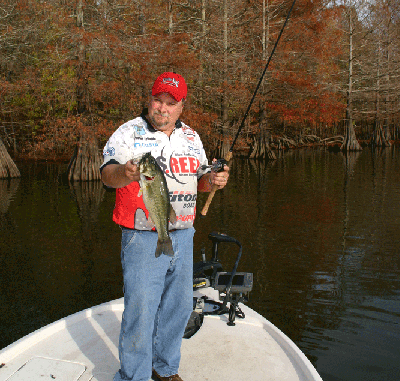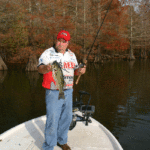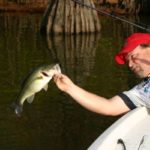
It’s hard to ignore this lake’s incredible crappie fishery, but if you can, you’ll watch your rod curl over some whopper bass.
Twenty-five miles south of Jonesville, Larto Lake is tucked into some of the best backwater fishing in the state. Late winter bass action on Larto, with its oxbow shape, is a jig fisherman’s paradise.
Docks, cypress trees and planted brushpiles attract big fish and anglers in the late winter months. With a mix of Rat-L-Traps and spinnerbaits, finding key areas in the lake is not difficult. However, to fool a big momma of a bass, a jig and trailer is the best option an angler has for Larto’s March bass.
Larto has an oxbow shape like many lakes down the Mississippi, Red, Ouachita and Black rivers. However, earthquakes had the biggest hand in shaping the current lake. Saline Lake, Black River and numerous canals and bayous create a vast area for anglers to investigate. The fluctuating Black and Red rivers impact the fishery and area waters. Careful anglers plan trips based on river levels or recent rainfall to avoid times when the water is high or muddy.
Two anglers who know how to catch Central Louisiana bass are Porter Trimble, Honey Brake guide and tournament angler, and Danny Smith, B.A.S.S. Central Open Red River winner. Years of experience and local tournament wins make the pair a valuable resource for area anglers.
“Larto is only a small part of the Saline/Larto complex,” said Porter, who is the tournament director for the ABA B.A.S.S. Weekend Series Louisiana division. “Bass fishing is great year round throughout the many bayous and lakes near Jonesville, but March is the time to catch a trophy.”
Larto’s shorelines are covered with cypress trees, numerous docks and tree tops. Jigs, like a Stanley Flip-Max paired with an Uncle Josh Pork Chunk or Berkley Chigger Craw, easily imitate a Cajun crawfish. Cover, like the many cypress trees that line the shoreline, provide a safe place for bass to hide, tend to hold heat on sunny days and provide a home for a variety of food sources.
Places with deep water nearby, wood cover, and sunlight to warm the trees are focal points for big bass in the late winter months. Whether the jig is hopped, swum or dragged, contact the cover to trigger bites from resident bass.
“I like to use a 1/2- to 3/4-ounce jig like a Hack Attack with green pumpkin Rage Craw trailer,” Trimble said. “A heavier jig falls faster and triggers more reaction bites.”
Black/blue, black/red flake and dark colors imitate basic color patterns of Louisiana crawfish. Many times color selection comes down to water clarity. For muddy water, anglers should stick to darker colors because dark colors throw a better outline in murky water that is easier for the bass to see. If winter rains and flooding is at a minimum, natural color schemes like watermelon or green pumpkin are popular with local tournament anglers. If bream are popping in the trees and cover, add some chartreuse, orange or purple to the jig to mimic nest-robbing panfish.
“Be sure to bring a few light jigs when the fish move very shallow or tight to the bank,” suggested Smith, who used a jig to win the Red River Open in 2007. “A small profile, quiet entry and slow fall are important when the fish are up in a foot of water.”
Rapid changes in wind and weather during late winter make locating fish a challenge. Passing cold fronts drop water temperature and make bass lethargic. Heavy rains may muddy the waters. Other factors like high barometric pressure, wind and constantly changing conditions put bass fishing into the challenging category. Moving baits, like Rat-L-Traps and Stanley Spinnerbaits, cover water, which will help an angler narrow down the lake to a few productive areas. Every cypress tree looks like a hotspot on Larto.
Go for thump and vibration when searching for late-winter bass on Larto. Bass often react to large blades and rattles to protect their area. A few reaction strikes in a clump of trees or docks mean more fish may be in the area. Switch back to a jig to probe the stretch of bank where several key bites occur. Often, the smaller males will react to the moving baits, but the big females take the jig over the moving baits. Big fish did not get fat by chasing their food. Slow and easy is what works for late-winter female bass.
“Water clarity is important when choosing a spinnerbait,” Trimble said. “White, chartreuse and blue combinations are better in clear water. Plain chartreuse is good for muddy water. Also, rubber skirts are great for Larto’s winter bass.”
“Large thumping blades like a big Colorado are good for bumping around wood cover,” Smith said. “A Stanley Wedge spinnerbait with a gold No. 5 willow blade in the back and a silver No. 3 in front is another bait to try. I use chartreuse/white for late winter fish for stained to slightly muddy water.”
Larto may be known as a premiere crappie lake across the country. Locals know the lake as a productive bass fishery that takes 20-plus pounds to win tournaments February through April. Add in a chance to catch a 6-plus-pound Catahoula Parish hawg, and Larto has jig-fishing paradise written all over it.

